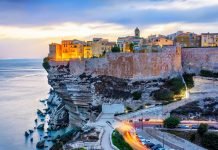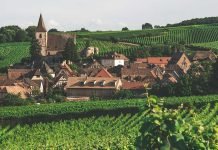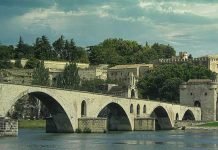Normandy is more than a place to visit; it’s a place to experience. Every town, every village, every rolling hill and rugged cliff tells a story – a story of past conflicts and present-day peace, of age-old traditions and forward-thinking innovation, of humble apples and gourmet delights. It is a tapestry of experiences, woven together by the indomitable spirit of its people and the enduring appeal of its landscapes. For the discerning traveller, a journey through Normandy is a feast for the senses, a thrill for the mind, and a balm for the soul.
- Historical richness: Normandy is steeped in history, from the Viking invasions and William the Conqueror to the defining D-Day landings of World War II.
- Picturesque coastal towns: Home to towns like Honfleur and Étretat that encapsulate the romantic charm of France.
- World War II landing beaches: Walk the sands of Omaha and Utah beaches, the sites of heroic wartime landings.
- Stunning cliffs: Marvel at the breath-taking cliffs of the Alabaster Coast, shaped by centuries of wind and water.
- Normandy American Cemetery and Memorial: A solemn tribute to American soldiers who fought and died on these shores.
- Mont Saint-Michel: A captivating island commune, and a UNESCO World Heritage site.
- Local cuisine: Savour the flavours of Camembert, cider, and Calvados.
- National Parks: Explore the verdant landscapes of the Boucles de la Seine and Marais du Cotentin and Bessin parks.
- Impressionist Art: Discover the roots of the Impressionist movement in the region that inspired Monet and other masters.
- Architectural Wonders: Admire the spectacular architecture of Cathédrale Notre-Dame in Rouen and Château de Caen.
Journey Through Normandy’s History
Normandy’s history is as multifaceted as its landscapes, characterized by centuries of territorial struggles, influential rulers, and transformative events. The region derives its name from the Viking, or ‘Northmen’ invaders, who sailed up the Seine River in the 9th and 10th centuries, ultimately making Normandy their home and lending the region its name.
Under the rule of these Viking settlers, notably Rollo and later his descendants, Normandy became a significant power. Still, its influence truly amplified under the rule of William the Conqueror, Duke of Normandy. In 1066, William embarked on the monumental Norman Conquest of England, culminating in the famous Battle of Hastings. His victory marked the beginning of Norman rule in England and profoundly influenced the English language and culture.
Normandy’s historical canvas continues into the later centuries, with the region frequently switching hands between English and French rule during the Hundred Years’ War. Yet, it is perhaps the 20th-century events of World War II that thrust Normandy most notably onto the global stage.
On June 6, 1944, codenamed D-Day, the Allies launched the largest seaborne invasion in history on the beaches of Normandy. This marked the beginning of the end for Nazi-occupied Europe. Today, the D-Day landing beaches stand as silent witnesses to history, drawing visitors from around the world to pay homage to the courage and sacrifice of those who fought for freedom.
A Tour of Normandy’s Major Towns and Cities
Normandy’s towns and cities, each with its unique charm and character, tell the tales of the region’s rich past and vibrant present. Le Havre, the region’s busiest port city, marries modern architecture with industrial charm. Heavily bombed during World War II, it was rebuilt by architect Auguste Perret and is now a UNESCO World Heritage site for its unique blend of modern architecture and historical integrity.
In contrast to Le Havre’s bustling modernity, Deauville, sometimes referred to as the ‘Parisian Riviera,’ offers old-world charm and elegance. Its grand casino, luxurious hotels, and horse-racing tradition have long attracted the French elite, while its annual American Film Festival adds a touch of Hollywood glamour.
Rouen, the historic capital of Normandy, is a city that wears its history on its sleeve. From the stunning Gothic Cathédrale Notre-Dame to the timber-framed houses of its old town and the tower marking the spot where Joan of Arc was executed, Rouen is a city where history lives and breathes.
Honfleur, a picturesque port town, captures the romantic essence of Normandy. With its well-preserved 16th- to 18th-century buildings, winding cobblestone streets, and vibrant art scene – it was a favourite of artists such as Boudin and Monet – Honfleur offers a timeless charm that’s hard to resist.
Unveiling Normandy’s Natural Wonders
Nature has been generous to Normandy, blessing it with a diverse landscape that shifts from rugged cliffs to verdant pastures, tranquil marshlands, and picturesque beaches. The cliffs of Étretat, with their dramatic natural arches and white chalk towers, are a sight to behold. The stunning Alabaster Coast, stretching for 130 kilometres, has earned its place on the canvas of many Impressionist painters with its unique light and changing moods.
Protected within the region’s boundaries are two significant national parks: the Boucles de la Seine Normande and the Marais du Cotentin et du Bessin. The former, located in a large meander of the River Seine, is characterized by its rich biodiversity, while the latter, a vast expanse of marshland, is a haven for a variety of bird species, making it a paradise for nature lovers and bird watchers alike.
Savouring Normandy’s Cuisine: From Farm to Table
The region’s gastronomy reflects Normandy’s fertile lands and rich seas. Seafood, from scallops to oysters, mussels to sole, abounds along the coastline, while the lush inland pastures are prime territory for dairy farming. Indeed, Normandy’s cows, which outnumber its human residents, produce some of France’s most loved cheeses. Among these, Camembert reigns supreme. Soft, creamy, and mildly pungent, it’s a cheese that is synonymous with Normandy.
Cider and Calvados also feature prominently in Normandy’s culinary identity. The region’s mild, damp climate is ideal for apple cultivation, leading to a strong tradition of cider and Calvados production. Cider, whether brut (dry), demi-sec (medium), or doux (sweet), offers a crisp, refreshing accompaniment to any meal. Calvados, meanwhile, a potent apple brandy, is often enjoyed as a ‘trou Normand’ – a digestive aid sipped between courses during a long, gastronomic meal. Whether you’re a gourmand, a wine enthusiast, or simply a curious traveler, Normandy’s culinary scene promises to delight your taste buds.
The Cultural Lure of Normandy
Immersing oneself in Normandy’s rich cultural tapestry is akin to stepping into a living artwork. The region’s landscapes, capturing the delicate interplay of light and colour, have been immortal favourites of artists for centuries. Claude Monet, a pioneer of Impressionism, painted some of his most celebrated works in Normandy, capturing the evanescent beauty of Rouen’s cathedral under different lights and the serene, dreamlike quality of the water lilies in his garden at Giverny.
In turn, Normandy pays homage to its artistic heritage through museums such as the Musée d’Orsay in Rouen and the Musée des Beaux-Arts in Caen. These cultural institutions house extensive collections of Impressionist and post-Impressionist works, preserving the artistic legacy of the region and offering visitors a window into the creative brilliance of the past.
Historic Architecture: The Timeless Witnesses of Normandy
Normandy’s architectural splendour serves as a testament to its rich history and diverse cultural influences. At the heart of this architectural showcase is Mont Saint-Michel. This ethereal island commune, crowned by a soaring abbey, emerges from the sea like a mirage, captivating visitors with its mystical allure and architectural grandeur.
The region’s religious structures further underscore its architectural richness. The Cathédrale Notre-Dame in Rouen, one of the largest and most impressive Gothic cathedrals in France, features a stunning display of intricate stonework. Lisieux, the second most important site of pilgrimage in France after Lourdes, is home to the Basilica of Sainte-Thérèse, an imposing and ornately decorated edifice dedicated to Saint Thérèse of Lisieux.
Château de Caen, a robust and stately castle, offers another architectural marvel. Constructed by William the Conqueror, the Duke of Normandy, in the 11th century, the castle has witnessed many pivotal events in history, making it a fascinating visit for history enthusiasts.
Celebrating Normandy: Festivals and Events
Normandy comes alive with celebration throughout the year, hosting an array of festivals and events that add a special charm to a visitor’s experience. The annual D-Day Festival is a poignant commemoration of the region’s historical significance, where reenactments, parades, and fireworks bring history to life and honour those who fought for freedom during World War II.
For film enthusiasts, the Deauville American Film Festival is a highlight on Normandy’s cultural calendar. As one of Europe’s most prestigious film events, the festival draws filmmakers and stars from across the globe, turning the spotlight on American cinema amidst the coastal charm of Deauville.
Apple Magic: Normandy’s Orchard Traditions
In Normandy, apples are more than just a fruit; they’re an integral part of the region’s cultural and gastronomic identity. While vineyards carpet many French regions, Normandy’s landscape is adorned with sprawling apple orchards. From the delicate blossoms of spring to the bountiful harvests of fall, the apple is celebrated in all its forms.
Normandy’s cider houses and distilleries offer a fascinating insight into the art of cider and Calvados production, opening their doors to visitors eager to learn and taste. The region’s apple festivals, such as the one in Conches-en-Ouche, provide a delightful immersion into local traditions, where the humble apple takes centre stage in culinary creations, games, and festivities. To truly understand Normandy’s love affair with the apple is to experience its traditions and taste its produce firsthand.
Awe-Inspiring Religious Structures: Emblems of Normandy’s Spirituality
Normandy, steeped in a rich history of faith and reverence, is replete with awe-inspiring religious structures. Dominating the Normandy coast, the mystical Mont Saint-Michel stands as a sentinel of the past. This island commune is crowned by the Abbey of Mont Saint-Michel, an architectural masterpiece that conjures images of a time when faith dictated the highest artistic achievements. Its soaring gothic spires, intricate sculptures, and sturdy defensive walls exude an aura of tranquillity that transports visitors back to the Middle Ages.
Rouen’s Cathédrale Notre-Dame, an epitome of Gothic grandeur, is another marvel that punctuates Normandy’s skyline. It’s not just the cathedral’s size that astounds; the intricate stonework of its façade captures hearts, particularly at different times of the day when the changing light lends it a celestial glow. This ever-changing façade has been immortalised in Claude Monet’s series of paintings, each capturing the cathedral at various times of the day and in different seasons.
Art and Museums: The Creative Pulse of Normandy
Normandy’s unique landscapes and ethereal light have long provided the perfect muse for artists. The Musée des Beaux-Arts in Rouen, with its prestigious collection of art, is a testament to this artistic heritage. Housing works by illustrious artists such as Rubens, Caravaggio, and Delacroix, the museum takes visitors on a journey through the history of art. Its extensive Impressionist collection, in particular, is a highlight, celebrating the creative genius that this region has inspired.
Giverny is another art lover’s delight. Here, visitors can explore the house and gardens of Claude Monet, now preserved as a museum. Walking through these spaces, one can almost envision Monet painting his famous Water Lilies series, inspired by the tranquil beauty of his surroundings.
Normandy’s museums also offer deep insights into the significant events that have shaped our world. Among them, the Caen Memorial Centre for History and Peace stands out. Providing a comprehensive exploration of the conflicts of the 20th century, the museum offers an in-depth look at the Battle of Normandy and the D-Day Landings. It serves as a poignant reminder of the struggles faced by those during the war, encouraging reflection on the values of peace and reconciliation.



















